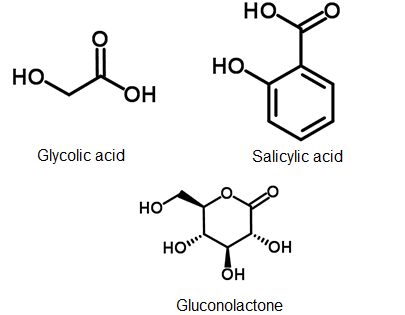Hydroxy acids are carboxylic acids that have at least one hydroxyl (OH−) group. These compounds, which are available as α-hydroxy acids, β-hydroxy acids, and polyhydroxy acids, are often used in skin care products. Hydroxy acids were first used in dermatology at concentrations higher than 20 percent to treat acne, psoriasis, and the effects of sun damage. Over-the-counter skin care products typically contain lower hydroxy acid concentrations and are most often sold as exfoliants, moisturizers, facial washes, and cleansers. See also: Carboxylic acid; Hydroxyl; Skin; Skin disorders

α-Hydroxy acids, such as glycolic and lactic acids, have carboxylic acid and hydroxy functional groups separated by one carbon atom. In β-hydroxy acids, such as β-hydroxybutanoic and salicylic acids, the carboxylic acid and hydroxy functional groups are separated by two carbon atoms. Polyhydroxy acids, such as gluconolactone (gluconic acid lactone) and lactobionic acid, contain multiple hydroxyl groups. (A lactone is a cyclic ester derived from a hydroxy acid.) See also: Lactone
Over-the-counter skin care products are considered by the U.S. Food & Drug Administration (FDA) to be cosmetics and therefore are not subject to regulatory approval. They are typically deemed safe by industry associations such as the Cosmetic Ingredient Review. Drugs, however, are regulated by the FDA. The emergence of over-the-counter products claiming both medicinal and cosmetic benefits, called cosmeceuticals, has created a gray area because the products’ drug benefits have not been scientifically tested. Some skin care product claims fall within this classification. Individual products aside, numerous benefits have been reported for hydroxy acids as skin treatments, but not all have been substantiated. See also: Pharmaceuticals testing
There is evidence that α-hydroxy acids may show anti-aging effects, such as decreased wrinkles and discoloration as well as increased collagen density. Products containing glycolic and lactic acids, for example, are considered safe for consumers at a 10 percent maximum concentration and a 3.5 minimum pH. However, their labels must contain a warning stating that α-hydroxy acids may increase skin sensitivity to sunlight and that consumers should use sunscreen and wear protective clothing. Polyhydroxy acids are considered less irritating and better for moisturization than glycolic and lactic acids because of their multiple hydroxyl groups. Gluconolactone also provides some protection against ultraviolet radiation. See also: Collagen; pH; Ultraviolet radiation (biology)





